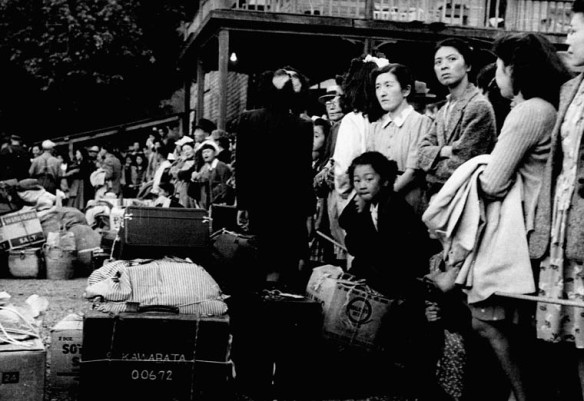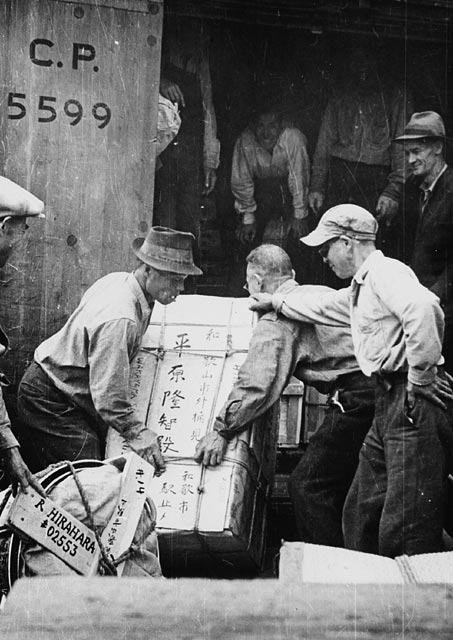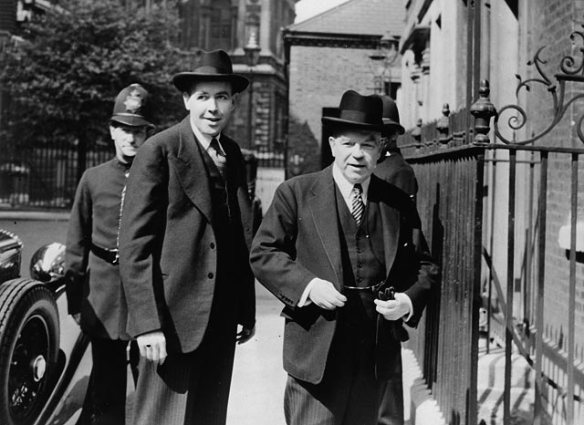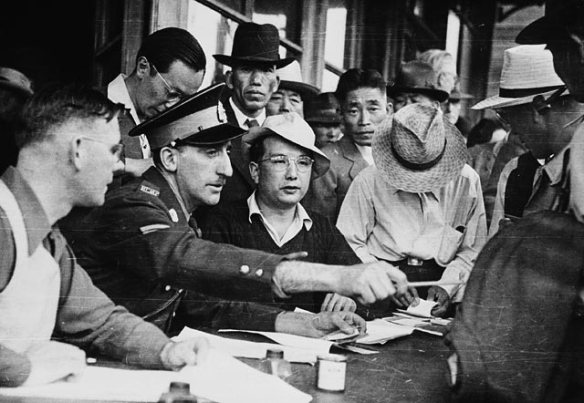By R.L. Gabrielle Nishiguchi

A group of Japanese Canadian deportees, who had been interned during the Second World War, waiting for a train to take them to a ship bound for Japan. Slocan City, British Columbia, 1946. Credit: Tak Toyota (c047398)
For just one evening, on September 20, 2018, Library and Archives Canada (LAC) will exhibit a bound, time-worn 1946 ledger with a blue cover. This small exhibit is part of “Revisiting Japanese Canadian Redress: Conference on the 30th Anniversary of the Agreement,” an event co-hosted by LAC and the Ottawa Japanese Community Association.
Why is this ledger so important? The pink pages, imprinted with fading purple Gestetner ink, show the names of 3,964 Japanese Canadians—among them almost 2,000 Canadian-born children—who were deported to war-ravaged Japan in 1946. The deportees represented about one fifth of some 20,000 Japanese Canadians who were forcibly removed from the West Coast in 1942. Each person’s entry includes the following information: registration number, date of birth, sex, marital status, national status, the place of departure, whether the person had signed the survey form (more about this below), and remarks such as “mental hospital,” “mentally unbalanced [and] unable to sign,” “New Denver Sanitorium,” “illeg[itimate],” “adopted,” “common law” and “Canadian Army.”
The word “Repatriates” is handwritten on the cover in fountain-pen ink. “Repatriation” is the expression used by the Canadian government to describe what scholarship and research have shown amounted to deportation. This term is often paired with the word “voluntary” (as we shall see, it was not). By definition, Canadian-born children whose only connection to Japan was their racial origin could not be “repatriated” to Japan.
Beside certain names are handwritten ballpoint and fountain-ink annotations. LAC has other copies of bound ledgers similar to the one on display, but what makes this particular copy so valuable are the handwritten annotations it contains. These annotations appear to be citations from statutes or Orders in Council (e.g., Privy Council Order 7356, December 15, 1945) that indicate how Canadian immigration officials would be able to prevent certain deportees from returning to Canada.
Recognizing the value and the historical significance of the ledger, LAC immediately scanned the pages to preserve the information they contained.
By doing so, LAC took steps to preserve the power of a name in our country’s memory. The names and information about the deportees bear silent but powerful witness to the suffering of those 3,964 men, women and children who ended up in a defeated and starving Japan and who were effectively barred from returning to Canada solely on the basis of their racial origin.

Three Japanese Canadian men, one of whom could be 42-year-old Ryuichi Hirahara (Registration Number 02553), loading a crate. Mr. Hirahara and his 40-year-old wife Kazu Hirahara (Registration Number 02554) were both Japanese nationals and interned in Slocan City, British Columbia. The shipping label is addressed to “Ryuichi Hirahara” at an address in Wakayama City, Japan. Mr. Hirahara requested that his belongings be held for him at the Wakayama Train Station, since he could not be sure that his ancestral home had survived the war. He did know that train stations would be among the first buildings to be rebuilt, since trains were critical to rebuilding Japan’s infrastructure. The Hiraharas were deported to Japan in 1946. Credit: Tak Toyota [Translation: Dr. Henry Shibata] (c047391)
The deportee: Henry Shibata
At the “Revisiting Japanese Canadian Redress” event on September 20, participants not only will be able to view the ledger, but also can meet 88-year-old Canadian-born Henry Shibata, who was deported to Japan in 1946 and whose name is inscribed in the ledger on display.
In the ledger, beside his name and the names of all six of his Canadian-born siblings, we find handwritten annotations (which appear to be statute citations). If these citations are indeed equivalent to the annotations referring to Privy Council Order 7356—the order that barred the return of any deported naturalized Japanese Canadians—then the Canadian government’s intention was to bar Henry and his siblings from returning to Canada.

The Rt. Hon. W.L. Mackenzie King and Mr. Norman Robertson attending the Commonwealth Prime Ministers’ Conference, London, England, May 1, 1944. Around this time, Norman Robertson, Under Secretary of State for External Affairs, and his special assistant Gordon Robertson (no relation) developed the deportation plan approved by Prime Minister Mackenzie King. (c015134)
The survey that would change everything
In the spring of 1945, the government of Canada surveyed every Japanese Canadian 16 years or older, including those in internment camps and even patients being treated in a psychiatric hospital, and compelled each person to choose whether he or she would go to Japan or east of the Rockies. Signing a form—which was part of this massive survey—and choosing to go to Japan was treated as prima facie evidence of disloyalty to Canada by the federal government, and an automatic cause for segregation and deportation. This information was expressly not provided to the Japanese Canadians forced to make this life-altering choice.
They did not understand what they were signing: in effect, their application for deportation. In fact, several of the annotations in the ledger, written by a bureaucrat, even include the phrase “app[lication] for deportation.” The survey was conducted by the Royal Canadian Mounted Police. Japanese Canadians who had been interned in detention camps in the interior of British Columbia, who found themselves forced to work on Prairie sugar beet farms to keep their families together, who were forced to work in isolated road camps, or who had been interned in prisoner-of-war internment camps for protesting their separation from their wives and children, were discouraged and afraid for their futures. Many had survived three long years in internment camps, where they could not move beyond camp boundaries without a pass.

Royal Canadian Mounted Police constable checking documents of Japanese Canadians being forced to abandon their homes and go to internment camps, 1942. Credit: Tak Toyota (c047387)

Internment camp for Japanese Canadians, Lemon Creek, British Columbia, June 1945. Credit: Jack Long (a142853)
Why did the deportees sign to go to Japan?
Pressure began with the community’s forced relocation from the West Coast in 1942. Then, starting in 1943, their property—held in trust by the federal Office of the Custodian of Enemy Property—had been auctioned off without their consent. Internees had been forced to live off the monies realized from these sales, essentially paying for their own internment. Moreover, internment camp supervisors were graded on how many signed forms they could obtain.
Those Japanese Canadians who ended up signing were the most vulnerable internees: persons with family trapped in Japan, single-parent families and psychiatric patients (some of whom were too sick to sign). Some with limited English-language skills felt that they were too old or too destitute to start their lives over in typically hostile communities to the east. There were also some older Canadian-born children who felt compelled to accompany their aging or sick parents to Japan.
In the case of young Henry Shibata’s family, interned in Lemon Creek, British Columbia, parents Hatsuzo and Tomiko had family in Hiroshima and had not heard whether anyone had survived the atomic bomb. Henry’s father, Hatsuzo, also felt that his own lack of written English would make it next to impossible to start over at the age of 52 in Eastern Canada. With the birth of his child Hisashi in the Lemon Creek internment camp, Hatsuzo Shibata now had a wife and seven children to support.
During the “Revisiting Japanese Canadian Redress” event on September 20, the deportation ledger will be opened to page 394, the page with the Shibata family entry. At this event, Dr. Henry Shibata will see his name in this ledger for the very first time, 72 years after he sailed to Japan on the SS General Meigs. Now 88 years old and a renowned Canadian surgical oncologist, he will see the original ledger page recording his family’s deportation.

Japanese Canadians being deported to Japan after the Second World War on the United States Army Transport SS General Meigs at Canadian Pacific Railway Pier A in Vancouver, British Columbia. Left to right: Corporal R.A. Davidson, Royal Canadian Mounted Police; C.W. Fisher; T.B. Pickersgill, Commissioner of Japanese Placement, Department of Labour, June 16, 1946. (a119024)
Despite the brutal and unspeakable hardships endured by Henry and his family in Hiroshima—a city turned to cinders by the first atomic bomb—Henry managed to graduate from Hiroshima Medical School. Dr. Shibata returned to Canada in 1961, after spending four years in the United States studying to become a surgeon. Through his expertise, Dr. Shibata has helped save many Canadian lives. He retired as a Professor Emeritus of McGill University in 2015.
The above-mentioned ledger, with its annotations, was the practical means of barring the return of the deportees. A senior civil servant succinctly expressed the intention of the annotations. On May 4, 1950, Arthur MacNamara, the Deputy Minister of Labour, wrote to Humphrey Mitchell, the Minister of Labour: “The External Affairs Department seem inclined to agree that men who were born in Canada and who … were sent to Japan might now be allowed to come back. This seems to me a matter on which there should be masterly inactivity. Even in the case of men or women born in Canada it does seem to me that they should be ‘allowed to suffer for their sins.’ After all they chose to go to Japan; they were not compelled.” (RG27, Volume 661, File 23-2-18, Deputy Minister of Labour Arthur MacNamara to Minister of Labour Humphrey Mitchell)
Co-Lab challenge
LAC’s new crowdsourcing tool, Co-Lab, gives Canadians the chance to collaborate with LAC by using their personal computers. LAC plans to host the ledger images in a Co-Lab challenge in the coming months, but you can see these images right now using Collection SearchBeta.
Canadians who have been moved by the story of the deportations and who wish to help keep the names of the deportees alive will have the opportunity to collaborate with LAC and transcribe the 3,964 names and the associated information. LAC hopes that a searchable transcription of the ledger will enable reseachers to decipher the critical handwritten annotations and compile more statistical information on the deportees.
We cannot change history and prevent those deportations, but we can solve the mystery of the annotations. We can also make sure that each entry remains accessible to the deportees, their families and researchers around the world, so that all of us can experience the power of these names; so that we shall never forget the human suffering embodied in them or the talent and promise we prevented from enriching Canada.
In the meantime, LAC has compiled photographs of Japanese Canadian internment in a Co-Lab challenge and is seeking your help to write descriptions and add keywords that further contextualize these historic photographs and increase the “discoverability” of these records. Try the challenge now!
Know more about the Co-Lab tool and the Collection SearchBeta by reading this previous blog post: Introducing Co-Lab: your tool to collaborate on historical records
More on LAC’s website
Learn about the deportations, the internment camps in Canada and the Redress campaign, or consult our major collections, by visiting the Japanese Canadians web page.
R.L. Gabrielle Nishiguchi is an archivist in the Society, Employment, Indigenous and Governmental Affairs Section of the Government Archives Division at Library and Archives Canada.

































